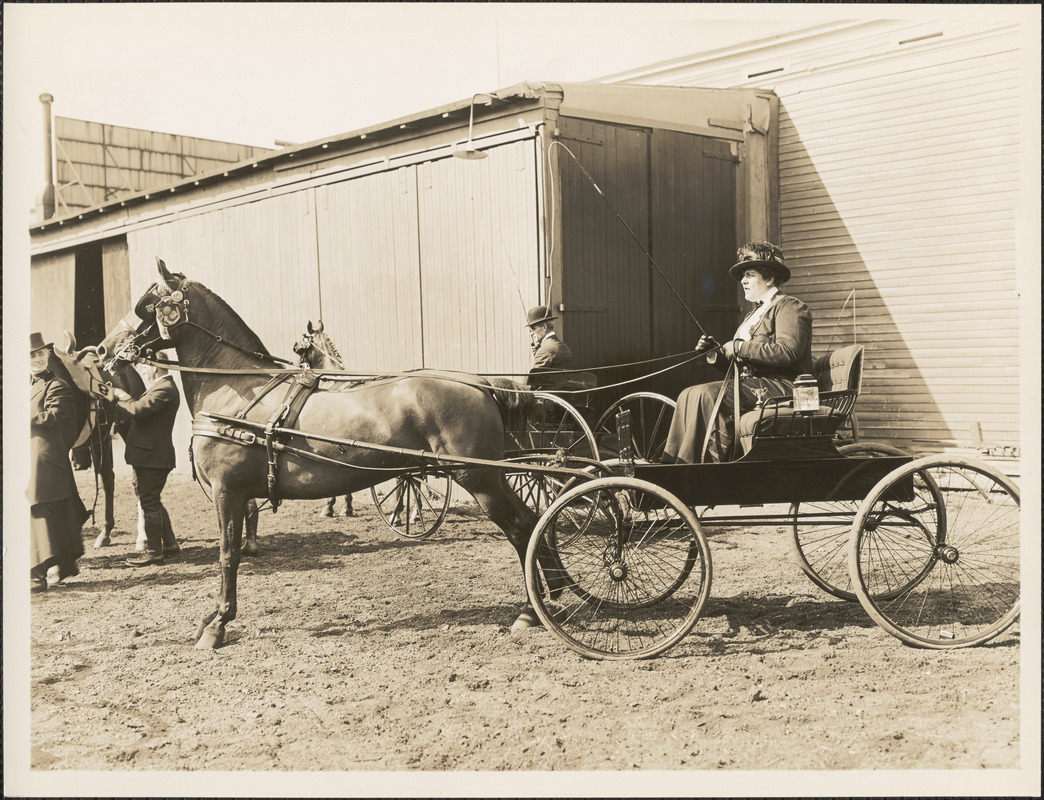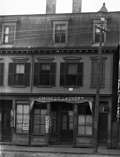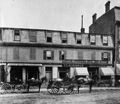|
The Society
Historical Information
Photo & Map Collections
Exploring Brookline
Links
Program Archives
|
Photo Collection
 |
Brookline Riding Academy, 2-4 Walnut St.
The Brookline Riding Academy, also known as the Brookline Riding School, opened November 1, 1895 right in the Village Square. It took over the large quarters of the car house and horse stables of the West End Railway Co. which had recently switched to electrified cars. The group is shown in the small lot outside the school. Alice Sargent and Dorothy Forbes, identified here, were wealthy equestrians who helped organize, from at least 1914-1917, an annual charity event hosted at the school with contests, prizes and trophies. A trophy is noted on the seat of Sargent’s carriage and the rear of the large billboard that faced the Village Square is observed.
Sargent, never married, lived her entire life in a 40-room mansion that was part of the Sargent family compound known as “Holm Lea” in the Warren St. area of Brookline.
[Source: Digital Commonwealth]
|
 |
Brookline Village Car House of the West End Railway Co.
#2 Walnut St, the car house of the West End Street Railway Co. The building was first erected in 1875 by the Metropolitan Railway Co. to house the horse-drawn cars servicing the Brookline-Roxbury Crossing-Tremont House line. It was closed as a car house in December, 1894, with the move to new electrified routes, and demolished in 1937.
[Source: Leo Sullivan]
|
 |
Juniper St. Horse Car Stables
Juniper St. looking north toward Morss Ave. The brick structure was the stable for the horses of the West End Street Railway Co. The second floor openings are for hay.
[Source: Leo Sullivan]
|
 |
8 Walnut St.
The old car barn of the West End Railway Co. is seen on the left. This photograph was made by one of the streetcar companies so it is likely that they were renting out the house.
[Source: Leo Sullivan]
|
 |
Brookline Village, Early 1900s
Looking west toward Boylston St., Washington St. curves to the right by the Guild Building. In the foreground left at the intersection of Walnut St. and Washington St. is an apartment building whose right-side first floor was converted to a store front in early 1900. At the corner of the building a door was added and given the address of 122 Washington St. It opened as a third Brookline location of C. E. Riley’s cigar stores and changed to Heleotis Bros. Fruits and Ice Cream in 1904. This is most like the Riley store which also advertised itself as a waiting room for trolley riders.
Atop the Guild Building in the center of the photo is a massive billboard advertising “Gilchrist”. This probably refers to a large department store on Winter St., in Boston. Oddly, no other photos of the Guild Building show a billboard of any type.
|
 |
Sing Lee Chinese Laundry, Lower Washington St., circa 1891
Just east of the intersection of High St. and Boylston, next to Hose House #1. Torn down before 1908 for the construction of the present day firehouse. Orignally numbered 66 before renumbering of Washington St.
1) Note the "Employment Office" sign by the entrance to the stairs next door at #68. This was likely the office of Mrs. Benjamin Hill. Brokers like this were often the source of servants for the wealthy households of Brookline.
2) Note the "Board Rooms" sign on the second floor. Listed in the city directory as boarders at that address are Thomas Steward, hairdresser and Joseph Hartnett, carriage painter, who worked at Michael Quinlan’s carriage factory one block away at the southwest corner of High St. and Boylston St.
3) Note the "Ladies Pompadours Cut and Curled" sign to the left at the hair salon next door.
|
 |
Lower Washington St., mid 1930s
This is one of three photos taken of this block. Looking west toward the start of Boylston St. From left to right:
- The fire house, still standing
- The Brookline Savings Bank, building still standing
- The tall brick building known as the “Sagamore” which housed Burns Drug Co. at 127 Washington St., visible on the right side
- The Davis Candy Shop at 121 Washington St.
- The van of Leslie W. Whalen, a Brookline mover
- A car advertising Brick Bradford, a science-fiction comic strip in Boston’s Daily Record newspaper
- Partial view of The Village Spa at 115 Washington St., run by the Rozantes family who lived upstairs above the store.
[Source: Historic New England]
|
 |
Lower Washington St., mid 1930s
Looking west on lower Washington St. toward the start of Boylston St. In the center of the photo, situated across High St. from the fire station, the Ford sign of T. C. Baker, a Ford dealership at 2 Boylston St., is visible. This is one of three photos taken of this block.
[Source: Historic New England]
|
 |
First PCC Streetcar, Brookline Village, circa June 1937
Looking west on Lower Washington St. Shown is PCC streetcar 3001, the very first of a line of new “PCC” streetcars purchased by the Boston Elevated Railway Co. This car was the only car purchased from the St. Louis Car Co., all subsequent cars being purchased from the Pullman Co. In the rear, the ivy-covered fire station is visible. The waiting platforms in the photo were demolished in September 1938.
It is evident from the “No Stops” destination panel, and the fact that this car never ran on routes going through Brookline, that this is one of the demonstration/training runs conducted following the delivery of the car in May 1937. The car was given the nickname of “Queen Mary” and began regular service on June 24, 1937, running on routes that did not go underground as it only had doors opening on the right side. This car has been widely reported on by the enthusiast community and there is even a scale model available for purchase.
|
 |
Hose #1 House, Lower Washington St., Brookline Village, circa 1905
Formerly Good Intent Hose Company. Note mural in middle of façade.
|
 |
South Side, Lower Washington St., 1905
The stores are bedecked with banners celebrating the bicentennial These buildings were all demolished in 1907-1908 and the current fire station was opened on this site in 1909.
[Source: Digital Commonwealth]
|
 |
Lower Washington St. August, 1933
Looking east from the Village Square
[Source: Leo Sullivan]
|
 |
Lower Washington St., Brookline Village, circa 1905
The businesses viewed here, along the south side of Lower Washington St., were simultaneously sited at this location from 1904 - 1906. All the structures in this photo were demolished in 1907-1908 to make way for the new fire station which opened in 1909 and remains in use today. Note the man with his wheeled bucket, center photo, presumably scooping up horse droppings. Viewed from left to right:
- The business with the partial view of an awning is at the corner with Walnut St., the last building in this row. The best estimation is that it is the store of James Heleotis and John Sigalos Co., fruit [1904-1906]. The awning appears to advertise "Ice Cream Sodas" mirroring the sign at the corner entranceway visible in other photos.
- An enigmatic sign over the alleyway that seems to advertise a shooting gallery. This is currently unidentified.
- By the delivery wagon at #126 Washington St. are William Frawley, shoemaker [1889-1907]; and a bootblack, either W. L. Jacklin [1904] or Cromwell Felton [1905-1907].
- C. E. Riley, Cigars at #128 Washington St. [1900-1907]
- The awning at 134 Washington St. George W. Rix, Provisions and Transfer Market [1904-1907]
- Sing Lee, laundry, which was at #136 Washington St. for over 20 years [1883-1907]
- Hose House #1 and Chemical Engine #1 at #140 Washington St.
- P. J. Burns, Horse Shoe Forge at #144 Washington St. [1897-1907]
- Also at 144 Washington St. there remains a sign for R. Woodward who had a horse-shoeing business there from the 1860s until his death in 1892
- J. H. Pineo, carpenter and builder at 4 High St. (visible at corner of Washington St) [1901-1907]
|
 |
P. J. Burns, Horse Shoeing, Brookline Village, 1905
South side of Lower Washington St., #144, corner High St. Hose House 1 is partially visible on the left. Right rear, #4 High St. is partially visible. The fire station is showing banners for the 1905 bicentennial. These buildings were all demolished in 1907-1908 and the current fire station was opened on this site in 1909.
[Source: Digital Commonwealth]
|
 |
Brookline Village, circa 1875
This is a unique early photo of the section of Lower Washington St. that became known as “Russell’s Block”. From left to right:
- [145-147 Washington St.] Brown Brothers, Fruits and Vegetables, Provisions
- To the right of the door for the upstairs rooms is an unattributed sign advertising “Drain Pipe, Nails, Powder, Soft Lead, …. Hardware”
- [137-139 Washington St.] Thomas T. Robinson, Fine Groceries. He had recently taken over the business of Marshall Russell whose sign still remains in the photo.
[Source: Brookline Public Library]
|
 |
Lower Washington St., Brookline Village, circa 1898
Looking east at Lower Washington St. from Boylston St. This photo contains a rare view of the north side of Lower Washington St.
On the far left is the wooden structure known as the "Russell Block". From left to right it houses:
- [153 Washington St.] The kitchenware and variety store of Albert Levien. Levien was a Russian immigrant who arrived in the United States in 1882, at the age of nineteen. He first had a store just over the Boston border on Tremont St. but soon moved to this location in 1888. He lived upstairs for the first sixteen years and maintained the store for over thirty years.
- [145-147 Washington St.] The store with the three awnings is the provisions store of Thomas S. Brown
- [137-139 Washington St.] J. V. Pyne & Co., dry goods
The large brick building to the right of the Russell Block, 127-131 Washington St., houses Jacob Morlock's "Bakery, Restaurant, Provisions" with the Morlock Hotel on the upper floors.
On the right side of the photo, from right to left, the identifiable structures are Hose House #1/Ladder #2 followed by Sing Lee’s Laundry. Hook and Ladder Co. #2 was only briefly located here, between late 1897 to mid-1899, before moving to the fire station at 342 Washington St.
[Source: Digital Commonwealth]
|
 |
Village Square, November 9, 1899
Looking east at Lower Washington St. from the beginning of Boylston St. At the immediate left, at #1 Boylston St., is the workshop of the Johnson Bros., Masons. The photograph is dated November 9, 1899 by the Town Engineer who was taking elevations for an encroachment case, note the measuring pole held by the man. The latter appears to be the same man holding a pole in this photo.
[Source: Brookline Preservation Department]
|
 |
Memorial Day, 1923; Lower Washington St., Brookline Village
The Stephen F. Rutledge V.F.W Post #864. P. H. Tonra, Commander. Lower Washington St., Brookline Village. Stores are no longer standing. Current fire house visible, right rear. Edward Moloney is standing under the "JT Driscoll Plumbing" sign, he is the one in a hat instead of a helmet.
|
 |
High St. Corner, Brookline Village, circa 1905
Standing on the corner of Walnut St. and High St. looking northeast towards Lower Washington St. Left, on High St., is the rear of Henry J. Pineo, Carpenter and Builder. On the corner, with Walnut St. going to the right, are several outbuildings of Michael W. Quinlan, Carriages and Harnesses, whose main business is off screen to the left, on the corner of Boylston St. and High St.
[Source: Digital Commonwealth]
|
 |
Brookline Village. Horsecar at Morss Ave & Walnut St. Stable, 1893
This is the last remaining horsecar in Brookline. Service began in 1859 and will soon switch to electric. On the right is the corner of the car house at #2 Walnut St. The entrance to Morss Ave. is just to the left of that. #97 Washington St. is viewed left in the rear.
|
|